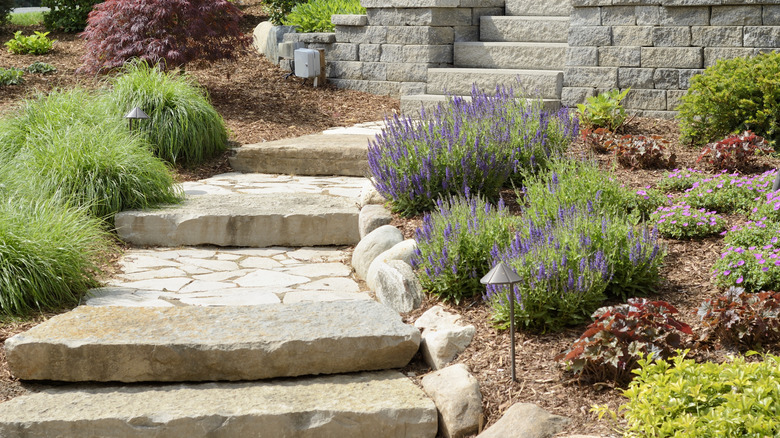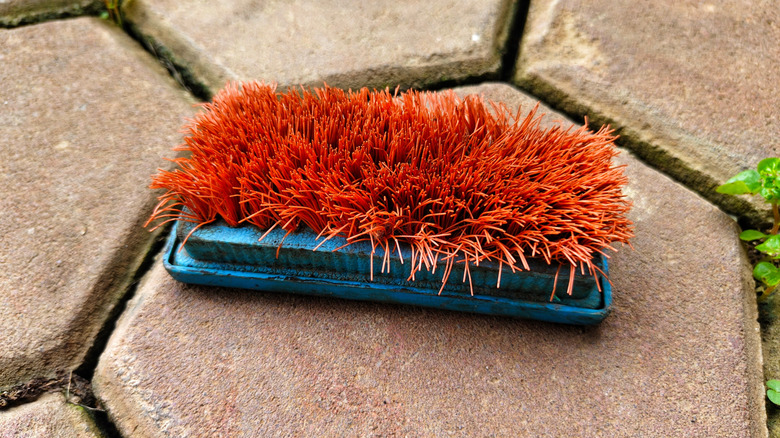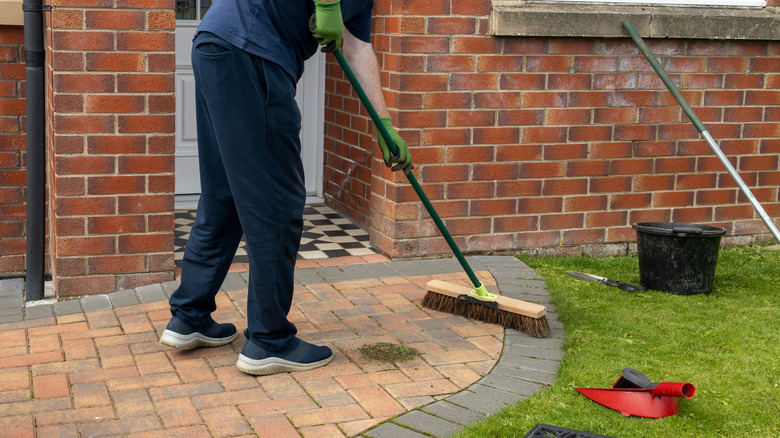The Best Ways To Remove Scratches From Pavers To Keep Them Looking Like New
Pavers are durable and versatile — there are many paver projects you can do to spruce up your home, from a stylish paver walkway project to a stunning backyard patio. When properly installed, pavers can last 20 to 25 years with little maintenance, and 50 years or more if you seal and maintain them consistently. Despite their longevity, pavers are susceptible to scratches and scuffs that can take away from the look of your finished area. Fortunately, though, you can bring your scratched pavers back to life with repairs including scrubbing, sanding, and patching, depending on the extent of the damage.
Unsealed concrete pavers are often the most vulnerable to wear and tear, but lower-quality brick pavers may also scratch easily. Natural stone pavers usually resist scratches and other marks quite well. Scratches can come from regular or rough use; on patios, scratches may happen due to chairs or tables being slid across the area, or heavy or sharp objects getting dropped on the pavers. Minor scratches and scuffing can be cleaned away relatively easily, and a deep clean will sometimes be enough to make those little marks disappear. If your pavers have deeper markings, though, you may need to do a little light sanding to smooth out the surface, or use patching material to fill in the scratches.
How to remove scratches from pavers
To refurbish your scratched-up pavers, start by cleaning them with a gentle brush and mild detergent to get rid of the dirt and debris in the scratches. If you're dealing with scuff marks or very shallow scratches, scrubbing the area thoroughly may be enough to remove them. Let the paver dry fully before you check the results, and if the scratches are still visible, you can move on to more intensive methods.
First, try using fine-grit sandpaper or a sanding pad to smooth the surface gently. Using fine-grit sanding products prevents additional scratches from forming. Use a uniform back-and-forth motion, and sand only as much as needed to eliminate the scratch. You can use medium-grit sandpaper if the fine-grit paper isn't effective, but use caution — the more abrasive material can remove too much of the surface if you're not careful. Work slowly, and check the scratches frequently.
Instead of sanding deeper scratches, consider filling them in with patching compound. Choose a patching product that matches your pavers' color as closely as possible to help it blend in. You'll get the best results by applying the compound to clean pavers and following the label directions for the specific product you choose. If these methods don't resolve the damage, the affected pavers may need to be replaced.
Preventing scratches on pavers
Regularly cleaning your pavers removes rocks and debris that could scratch them, but your cleaning method could also cause damage if you're not mindful. The best way to clean brick patio pavers to give them a refresh is by scrubbing them with a brush or push broom using a non-acidic cleaner. Avoid harsh cleaners and abrasive cleaning tools (acidic cleaners can damage the sealant on your pavers.) Pressure washers may be safe for use on natural stones, but if you have brick or concrete pavers, it's best to avoid them. Between washings, sweep the paver area regularly to get rid of debris buildup.
Periodically applying sealant to your pavers adds a layer of protection against scratches and scuffs. Use a sealant product specifically formulated for the type of pavers you have, whether brick, concrete, or stone. Typically, pavers should be resealed every three to five years, but this could vary depending on how much traffic they receive and how harsh the climate is.
During normal use, there are steps you can take to minimize scratching and other damage. For paver patios, avoid dragging furniture across the pavers; it also helps to add rubber or epoxy covers to the legs of your patio furniture, or place an outdoor rug underneath it. If you have trees or shrubs near your paved area, keep the branches trimmed to avoid having them fall onto the pavers, and use caution with metal tools or kids' toys near the patio.


